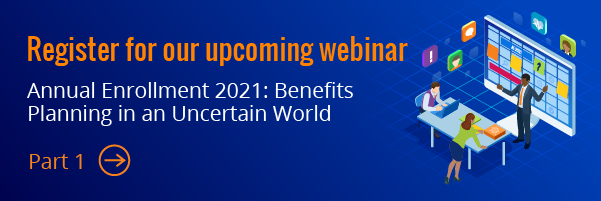All puns aside, preparation for 2021 annual enrollment is gearing up and it looks like it’s going to be an interesting season.

I hardly need mention how much things have changed since the beginning of the year. The goals and objectives, workforce challenges and financial realities employers faced just a few short months ago are now history. As I work with clients, one word that comes up constantly is “pivot.” HR and benefits staff are taking it day by day and adjusting to unexpected developments like the possibility of doing mid-year elections with no life events, or extending COBRA or other benefits-related deadlines.
This is the context in which AE planning is happening. With all the unknowns and changes you’d think everyone would be dizzy and exhausted from all that pivoting.
Instead, the opposite is playing out. Sure, people are tired, but they are also excited. HR and benefits folks are seizing this moment as an opportunity to take stock of their programs, their funding and their administration and working on ways to lay the groundwork for more flexible, cost-effective and responsive benefits. Our community is excited and is rising to the occasion, showing their immense value in terms of strategic thinking and problem-solving.
There is a lot of work going on—certainly more than I can capture in one blog—but here are four of the things that have employers’ attention for 2021:
- Rounding out their offering with voluntary benefits. Core benefits, like medical, dental, vision and life insurance, are just that. They are the backbone of many employers’ benefits programs, but by themselves don’t enable employees to really personalize their suite of options. Employers have been adding voluntary coverages, especially as a complement to high-deductible plans (think hospital indemnity and critical illness) but there’s greater recognition of the need for benefits that provide non-healthcare-related financial protections. For example, we’re seeing increased interest in identity theft protection. With reports of fraud related to stimulus and unemployment checks, the need for this benefit has become more obvious.
- Doubling down on accounts that help employees save. In early 2019, the shutdown of the Federal government shined a light on the financial fragility of many US employees. Recent events have punctuated that situation as millions of Americans lost their jobs and their benefits without a strong financial safety net. Employers are looking to highlight healthcare-cost-related accounts like FSAs and HSAs to ensure people take advantage of these important benefits. They are also looking more closely at post-tax accounts that enable people to save for non-healthcare expenses or create or add to a rainy day fund by contributing dollars directly from their paycheck.
- Exploring alternatives to traditional group health coverage. Most employers offer healthcare benefits by evaluating and choosing a finite set of options from which employees can choose once a year. The cost is split, and employers generally pay the larger amount. However, some employers are beginning to see the potential advantages of Individual Coverage HRAs (ICHRAs) either to extend benefits to groups that were not eligible under the group plan or to replace all or part of their traditional healthcare offering. ICHRAs just became available on Jan. 1 so adoption is in its early stages, and this approach may not be for everyone, but ICHRAs are the defined contribution approach to healthcare coverage that has been predicted for some time.
- Moving the needle on employees’ benefits experience. As employees’ location and method of working changed in the past few months, the way they interact with their benefits has evolved. Even before the pandemic, we saw increased use of both our mobile app as well as our AI-enabled personal benefits assistant, Sofia. These trends have been amplified and employers are taking notice. We hear lots of discussion around the benefits experience and benefits delivery. Employers still using paper or in-person enrollment meetings are radically rethinking their approach, and those with online platforms are stepping up their evaluation of whether their solutions are truly state-of-market and provides the best support for their workforce.
Benefits are never static, but this AE season, there seems to be more movement and more potential change. In the face of widespread and unanticipated workforce, social and economic shifts, HR and benefits professionals are using this moment in time to think critically about the employee-employer relationship, the benefits landscape and the way forward and engage in some transformational work .
Want to learn more about what your peers and benefits experts are working on in advance of 2021? Register for our upcoming webinar for more insights.



